Helen McNicoll (1879–1915) was one of only a small number of Canadian artists to fully adopt Impressionism as a style; indeed she pushed its fundamental principles further than any other Canadian artist. Hague School and Barbizon landscape works dominated the Canadian art market at the end of the nineteenth century. Gradually, however, a small number of collectors in Montreal showed an interest in modern French painting and, almost three decades after its introduction in Paris in the 1860s, Impressionism finally gained currency in Canada. Montreal, where McNicoll grew up, was the primary centre of Impressionism in Canada. In 1892, W. Scott and Sons Gallery sponsored the first exhibition of eight French Impressionist works, and others followed, including a show of delicate, Japanese-inspired etchings of modern women and children by Mary Cassatt (1844–1926) at the Art Association of Montreal (AAM) in 1907.
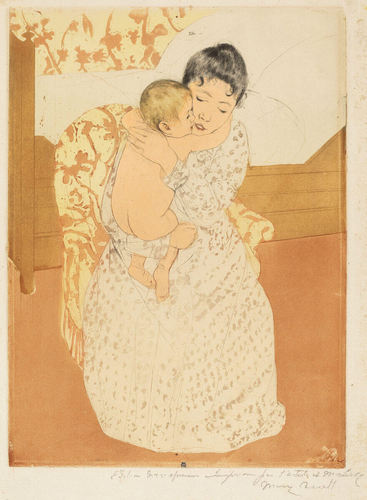
Colour drypoint and aquatint on cream laid paper, 43.5 x 30.3 cm, National Gallery of Art, Washington.
Cassatt’s series of ten Japanese-inspired prints tackles the themes of domesticity and femininity that also interested McNicoll.
McNicoll belonged to a second generation of Canadian Impressionists that included Clarence Gagnon (1881–1942) and Marc-Aurèle de Foy Suzor-Coté (1869–1937), both fellow Montrealers, and W.H. Clapp (1879–1954), with whom she shared the inaugural Jessie Dow Prize at the 1908 AAM Spring Exhibition. Both her winning canvas, September Evening, 1908, and Clapp’s, Morning in Spain, 1907, are clearly inspired by Impressionism. Reviews of the AAM Spring Exhibitions through the first decade of the twentieth century refer to these artists’ loyalty to the “New Painting” and the “French Method.”
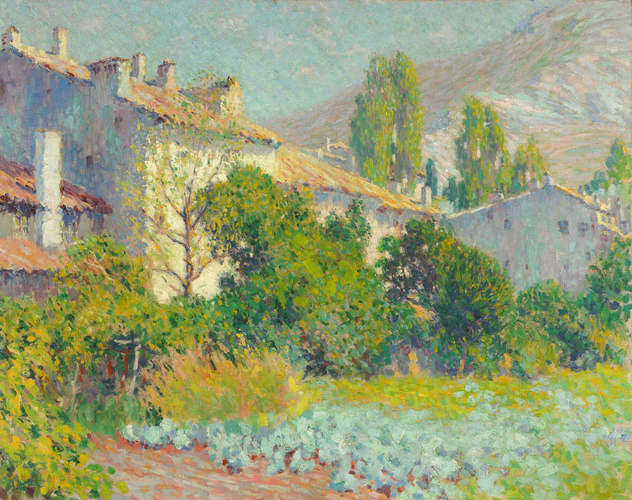
Oil on canvas, 73.9 x 92.6 cm, National Gallery of Canada, Ottawa
McNicoll’s cosmopolitan life played an important role in the spread of Impressionism from Europe to Canada. In a characteristic review from 1909, a critic wrote that “Miss McNicoll has for some time past been studying on the continent, and she has certainly caught the spirit of the modern French Impressionist school.”
McNicoll had moved to London in 1902, where she maintained a studio from 1908 until her death. She used the city as her home base while she travelled throughout England, France, and Italy, usually accompanied by her friend, companion, and fellow painter Dorothea Sharp (1874–1955) and often by a sister or cousin as well. She made trips to a number of rural artists’ colonies in France and England, milieus where Impressionism continued to exert a strong influence long after the revolutionary charge of its Parisian debut had dimmed.
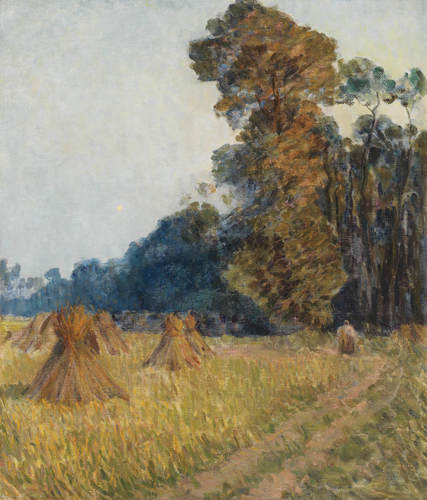
Oil on canvas, 71.8 x 62.2 cm, private collection, Toronto
Though the reception of Impressionism in Canada was frequently ambivalent and sometimes overtly negative, McNicoll’s work was almost unanimously well received. Some critics objected to her representation of water as rigid and unnatural—Fishing, c.1907, for example, drew this criticism—but reviewers were generally supportive of her efforts, saying that she avoided the “extreme effects and extravagant technique” of some of her peers. Her gender may partially explain this positive reaction: Norma Broude and Tamar Garb have noted that Impressionism was coded as a feminine style and that women Impressionists received positive notice for their soft, pretty treatments of everyday subjects, even as their male colleagues received criticism for those same qualities.
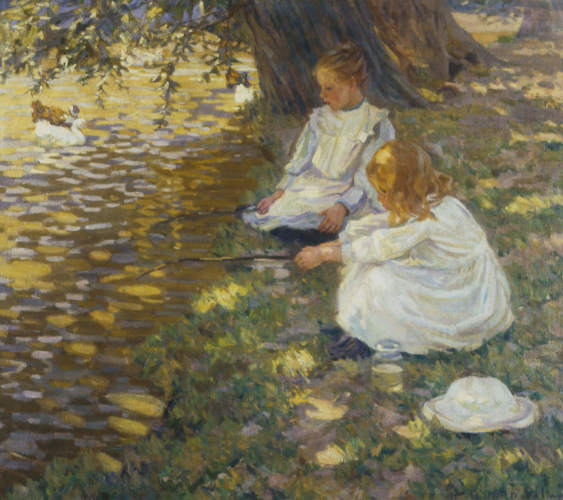
Oil on canvas, 87.6 x 101 cm, private collection
Impressionism had a short life in Canada. When McNicoll was receiving positive notice for her canvases, the movement was already nearly forty years old in France, and the established avant-garde movement was Cubism. By the time Impressionism was widely accepted by the public in Canada, artists such as Emily Carr (1871–1945), Emily Coonan (1885–1971), and the Group of Seven had moved on to Post-Impressionist styles. McNicoll’s own brief career neatly mirrors the short burst of attention given to Impressionism in Canada in its day.
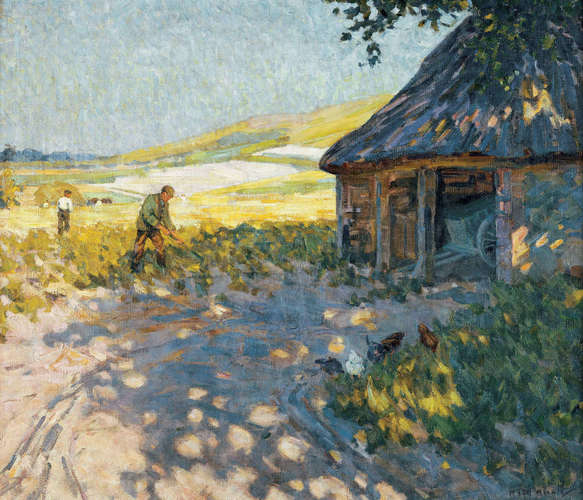
Oil on canvas, 61.8 x 72.2 cm, Art Gallery of Nova Scotia, Halifax
This Essay is excerpted from Helen McNicoll: Life & Work by Samantha Burton.
 Karen Tam’s Autumn Tigers
Bridging Past and Present: Invisible Made Visible
By Imogene L. Lim, PhD
Karen Tam’s Autumn Tigers
Bridging Past and Present: Invisible Made Visible
By Imogene L. Lim, PhD
 The Frontier Portraits of C.D. Hoy
A Chinese Canadian Photographer’s Tribute to His Community
By Faith Moosang
The Frontier Portraits of C.D. Hoy
A Chinese Canadian Photographer’s Tribute to His Community
By Faith Moosang
 Interrogating Identity
Suzy Lake explores the role of photography in shaping how we understand and see ourselves
By Erin Silver
Interrogating Identity
Suzy Lake explores the role of photography in shaping how we understand and see ourselves
By Erin Silver
 An Emboldened Artist
How Oviloo Tunnillie achieved rare international acclaim as an Inuit female sculptor
By Darlene Coward Wight
An Emboldened Artist
How Oviloo Tunnillie achieved rare international acclaim as an Inuit female sculptor
By Darlene Coward Wight
 Painting the Cultural Mosaic
William Kurelek traversed the country in a quest to capture its diverse inhabitants
By Andrew Kear
Painting the Cultural Mosaic
William Kurelek traversed the country in a quest to capture its diverse inhabitants
By Andrew Kear
 Domestic Discontent
Mary Pratt’s poetic scenes of home life are praised for their political edge
By Ray Cronin
Domestic Discontent
Mary Pratt’s poetic scenes of home life are praised for their political edge
By Ray Cronin
 A New Vision of the North
Annie Pootoogook’s art offers unprecedented insights into the contemporary Arctic
By Nancy G. Campbell
A New Vision of the North
Annie Pootoogook’s art offers unprecedented insights into the contemporary Arctic
By Nancy G. Campbell
 Meetings of Minds
Sorel Etrog found new ideas in collaborative work
By Alma Mikulinsky
Meetings of Minds
Sorel Etrog found new ideas in collaborative work
By Alma Mikulinsky
 Introducing Miss Chief
An excerpt from the ACI’s book “Revision and Resistance”
By Shirley Madill
Introducing Miss Chief
An excerpt from the ACI’s book “Revision and Resistance”
By Shirley Madill
 A Practice of Recovery
An excerpt from the ACI’s book “Revision and Resistance”
By Sasha Suda
A Practice of Recovery
An excerpt from the ACI’s book “Revision and Resistance”
By Sasha Suda
 Decolonizing History Painting
An excerpt from the ACI’s book “Revision and Resistance”
By Ruth B. Phillips and Mark Salber Phillips
Decolonizing History Painting
An excerpt from the ACI’s book “Revision and Resistance”
By Ruth B. Phillips and Mark Salber Phillips
 A Vision for the Future
An excerpt from the ACI’s book “Revision and Resistance”
By Nick Estes
A Vision for the Future
An excerpt from the ACI’s book “Revision and Resistance”
By Nick Estes
 Inside Kent Monkman’s Studio
An excerpt from the ACI’s book “Revision and Resistance”
By Jami C. Powell
Inside Kent Monkman’s Studio
An excerpt from the ACI’s book “Revision and Resistance”
By Jami C. Powell
 The Rule of Chance
Jean Paul Riopelle’s break with Automatism
By François-Marc Gagnon
The Rule of Chance
Jean Paul Riopelle’s break with Automatism
By François-Marc Gagnon
 From Taos to New York
Agnes Martin and the currents of American Art
By Christopher Régimbal
From Taos to New York
Agnes Martin and the currents of American Art
By Christopher Régimbal
 An Artist Blooms
Mary Hiester Reid’s floral aesthetics
By Andrea Terry
An Artist Blooms
Mary Hiester Reid’s floral aesthetics
By Andrea Terry
 The Patriotic Painter
Greg Curnoe’s Canada
By Judith Rodger
The Patriotic Painter
Greg Curnoe’s Canada
By Judith Rodger
 Walking, Stacking, Dancing
Françoise Sullivan’s conceptual 1970s
By Annie Gérin
Walking, Stacking, Dancing
Françoise Sullivan’s conceptual 1970s
By Annie Gérin
 The Extraordinary North
Tom Thomson’s diary of landscape
By David P. Silcox
The Extraordinary North
Tom Thomson’s diary of landscape
By David P. Silcox
 A Champion of Abstraction
Jock Macdonald sought a new expression in art
By Joyce Zemans
A Champion of Abstraction
Jock Macdonald sought a new expression in art
By Joyce Zemans